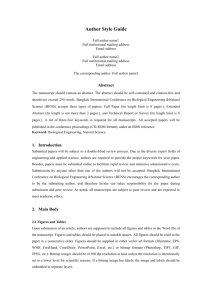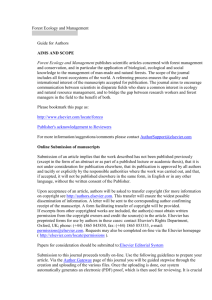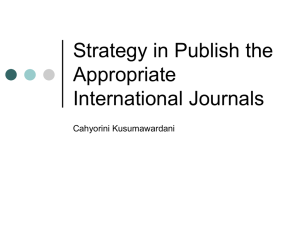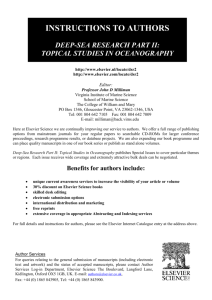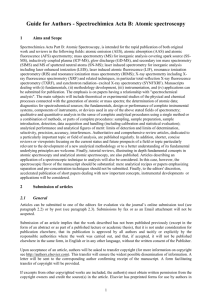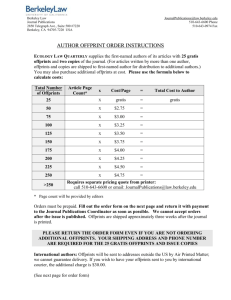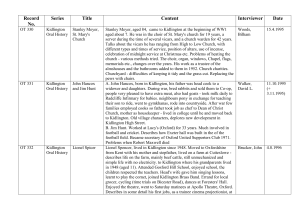Engineering Failure Analysis
advertisement
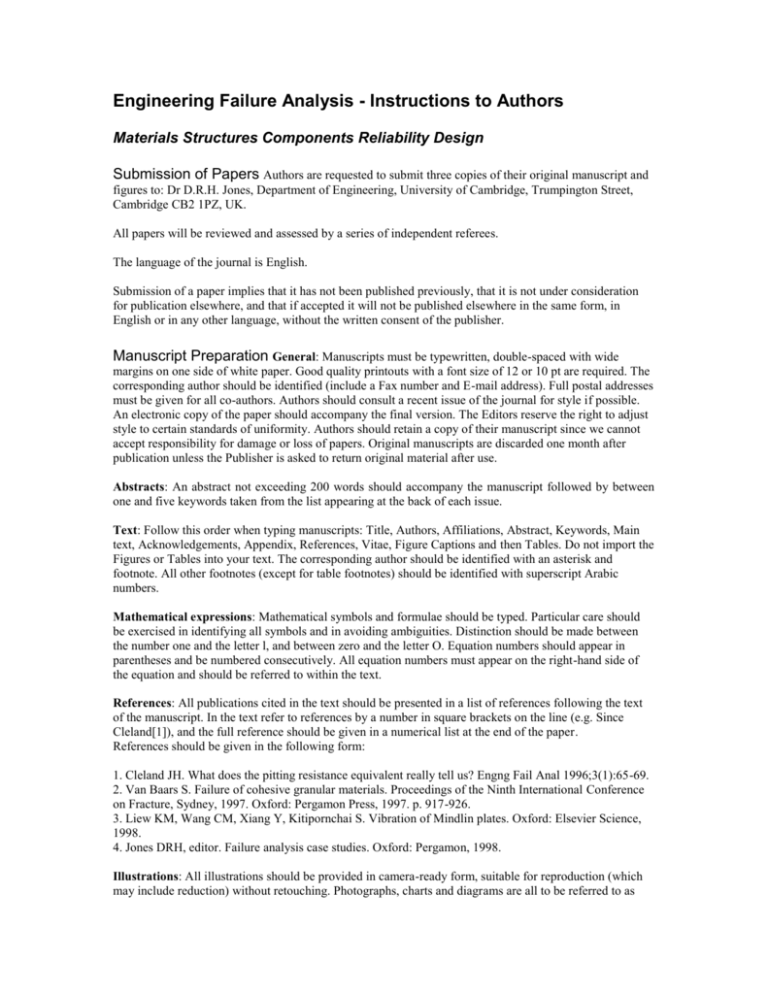
Engineering Failure Analysis - Instructions to Authors Materials Structures Components Reliability Design Submission of Papers Authors are requested to submit three copies of their original manuscript and figures to: Dr D.R.H. Jones, Department of Engineering, University of Cambridge, Trumpington Street, Cambridge CB2 1PZ, UK. All papers will be reviewed and assessed by a series of independent referees. The language of the journal is English. Submission of a paper implies that it has not been published previously, that it is not under consideration for publication elsewhere, and that if accepted it will not be published elsewhere in the same form, in English or in any other language, without the written consent of the publisher. Manuscript Preparation General: Manuscripts must be typewritten, double-spaced with wide margins on one side of white paper. Good quality printouts with a font size of 12 or 10 pt are required. The corresponding author should be identified (include a Fax number and E-mail address). Full postal addresses must be given for all co-authors. Authors should consult a recent issue of the journal for style if possible. An electronic copy of the paper should accompany the final version. The Editors reserve the right to adjust style to certain standards of uniformity. Authors should retain a copy of their manuscript since we cannot accept responsibility for damage or loss of papers. Original manuscripts are discarded one month after publication unless the Publisher is asked to return original material after use. Abstracts: An abstract not exceeding 200 words should accompany the manuscript followed by between one and five keywords taken from the list appearing at the back of each issue. Text: Follow this order when typing manuscripts: Title, Authors, Affiliations, Abstract, Keywords, Main text, Acknowledgements, Appendix, References, Vitae, Figure Captions and then Tables. Do not import the Figures or Tables into your text. The corresponding author should be identified with an asterisk and footnote. All other footnotes (except for table footnotes) should be identified with superscript Arabic numbers. Mathematical expressions: Mathematical symbols and formulae should be typed. Particular care should be exercised in identifying all symbols and in avoiding ambiguities. Distinction should be made between the number one and the letter l, and between zero and the letter O. Equation numbers should appear in parentheses and be numbered consecutively. All equation numbers must appear on the right-hand side of the equation and should be referred to within the text. References: All publications cited in the text should be presented in a list of references following the text of the manuscript. In the text refer to references by a number in square brackets on the line (e.g. Since Cleland[1]), and the full reference should be given in a numerical list at the end of the paper. References should be given in the following form: 1. Cleland JH. What does the pitting resistance equivalent really tell us? Engng Fail Anal 1996;3(1):65-69. 2. Van Baars S. Failure of cohesive granular materials. Proceedings of the Ninth International Conference on Fracture, Sydney, 1997. Oxford: Pergamon Press, 1997. p. 917-926. 3. Liew KM, Wang CM, Xiang Y, Kitipornchai S. Vibration of Mindlin plates. Oxford: Elsevier Science, 1998. 4. Jones DRH, editor. Failure analysis case studies. Oxford: Pergamon, 1998. Illustrations: All illustrations should be provided in camera-ready form, suitable for reproduction (which may include reduction) without retouching. Photographs, charts and diagrams are all to be referred to as “Figure(s)” and should be numbered consecutively in the order to which they are referred. They should accompany the manuscript, but should not be included within the text. All illustrations should be clearly marked on the back with the figure number and the author’s name. All figures are to have a caption. Captions should be supplied on a separate sheet. Line drawings: Good quality printouts on white paper produced in black ink are required. All lettering, graph lines and points on graphs should be sufficiently large and bold to permit reproduction when the diagram has been reduced to a size suitable for inclusion in the journal. Dye-line prints or photocopies are not suitable for reproduction. Do not use any type of shading on computer-generated illustrations. Photographs: Original photographs must be supplied as they are to be reproduced (e.g. black and white). If necessary, a scale should be marked on the photograph. Please note that photocopies of photographs are not acceptable. Colour: No colour graphics are published in this journal. Tables: Tables should be numbered consecutively and given a suitable caption and each table typed on a separate sheet. Footnotes to tables should be typed below the table and should be referred to by superscript lowercase letters. No vertical rules should be used. Tables should not duplicate results presented elsewhere in the manuscript, (e.g. in graphs). Electronic Submission Authors should submit an electronic copy of their paper with the final version of the manuscript. The electronic copy should match the hardcopy exactly. Always keep a backup copy of the electronic file for reference and safety. Full details of electronic submission and formats can be obtained from http://www.elsevier.nl/locate/disksub or from Author Services at Elsevier Science. Proofs Proofs will be sent to the author (first named author if no corresponding author is identified of multiauthored papers) and should be returned within 48 hours of receipt. Corrections should be restricted to typesetting errors; any others may be charged to the author. Any queries should be answered in full. Please note that authors are urged to check their proofs carefully before return, since the inclusion of late corrections cannot be guaranteed. Proofs are to be returned to the Log-in Department, Elsevier Science, The Boulevard, Langford Lane, Kidlington, Oxford OX5 1GB, UK. Offprints Twenty-five offprints will be supplied free of charge. Offprints and copies of the issue can be ordered at a specially reduced rate using the order form sent to the corresponding author after the manuscript has been accepted. Orders for reprints (produced after publication) will incur a 50% surcharge. Copyright All authors must sign the “Transfer of Copyright” agreement before the article can be published. This transfer agreement enables Elsevier Science Ltd to protect the copyrighted material for the authors, but does not relinquish the author’s proprietary rights. The copyright transfer covers the exclusive rights to reproduce and distribute the article, including reprints, photographic reproductions, microfilm or any other reproductions of similar nature and translations. This Includes the right to adapt the article for use in conjunction with computer systems and programs, including reproduction or publication in machinereadable form and incorporation in retrieval systems. Authors are responsible for obtaining from the copyright holder permission to reproduce any material for which copyright exists. Author Services For queries relating to the general submission of manuscripts (including electronic text and artwork) and the status of accepted manuscripts, please contact Author Services, Log-in Department, Elsevier Science, The Boulevard, Langford Lane, Kidlington, Oxford OX5 1GB, UK. E-mail: authors@elsevier.co.uk, Fax: +44 (0) 1865 843905, Tel: +44 (0) 1865 843900. Authors can also keep a track of the progress of their accepted article through our OASIS system on the Internet. For information on an article go to the Internet page: http://www.elsevier.nl/oasis and key in the corresponding author’s name and the Elsevier reference number.





